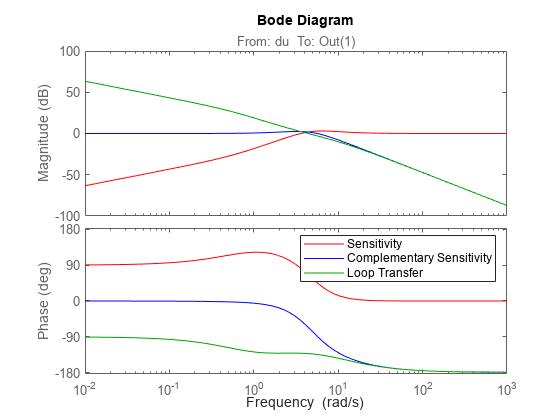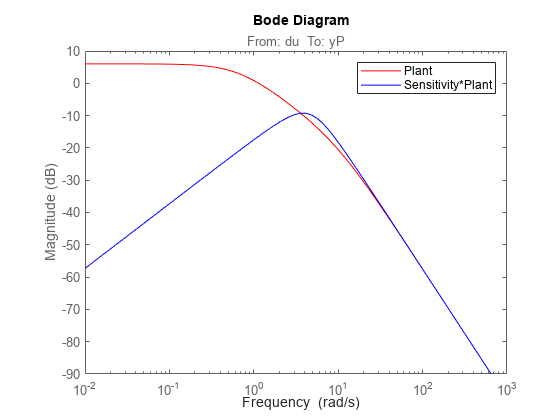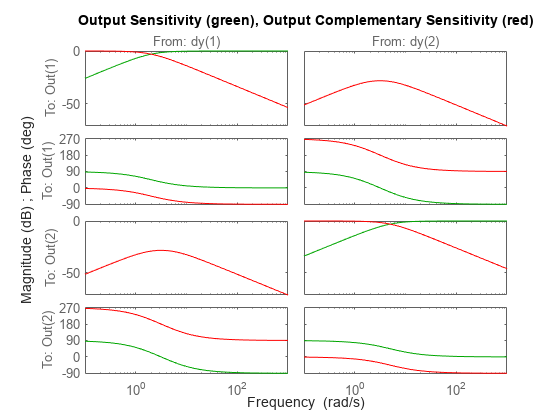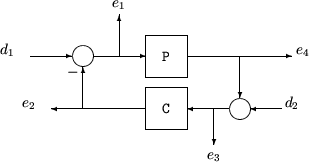loopsens
Sensitivity functions of plant-controller feedback loop
Syntax
Description
loops = loopsens(P,C)C in negative feedback with the plant
P. To compute the sensitivity functions for the system with positive
feedback, use loopsens(P,-C).
Examples
Consider PI controller for a dominantly first-order plant, with the closed-loop bandwidth of 2.5 rads/sec. Since the problem is SISO, all gains are the same at input and output.
gamma = 2; tau = 1.5; taufast = 0.1; P = tf(gamma,[tau 1])*tf(1,[taufast 1]); tauclp = 0.4; xiclp = 0.8; wnclp = 1/(tauclp*xiclp); KP = (2*xiclp*wnclp*tau - 1)/gamma; KI = wnclp^2*tau/gamma; C = tf([KP KI],[1 0]);
Form the closed-loop (and open-loop) systems with loopsens, and plot Bode plots of the sensitivity functions at the plant input.
loops = loopsens(P,C); bode(loops.Si,'r',loops.Ti,'b',loops.Li,'g') legend('Sensitivity','Complementary Sensitivity','Loop Transfer')

Finally, compare the open-loop plant gain to the closed-loop value of PSi.
bodemag(P,'r',loops.PSi,'b') legend('Plant','Sensitivity*Plant')

Consider an integral controller for a constant-gain, 2-input, 2-output plant. For purposes of illustration, the controller is designed via inversion, with different bandwidths in each rotated channel.
P = ss([2 3;-1 1]); BW = diag([2 5]); [U,S,V] = svd(P.d); % get SVD of Plant Gain Csvd = V*inv(S)*BW*tf(1,[1 0])*U'; % inversion based on SVD loops = loopsens(P,Csvd); bode(loops.So,'g',loops.To,'r',logspace(-1,3,120)) title('Output Sensitivity (green), Output Complementary Sensitivity (red)');

Input Arguments
Plant, specified as a dynamic system model, control design block, or static gain
matrix. P can be SISO or MIMO, as long as P*C
has the same number of inputs and outputs.
P can be continuous time or discrete time. If
P is a generalized model (such as genss or
uss) then loopsens uses the current or
nominal value of all control design blocks in P.
Controller, specified as a dynamic system model, control design block, or static
gain matrix. The controller can be any of the model types that P
can be, as long as P*C has the same number of inputs and outputs.
loopsens computes the sensitivity
functions assuming a negative-feedback closed-loop system. To compute the
sensitivity functions for the system with positive feedback, use
loopsens(P,-C).
The loopsens command assumes one-degree-of-freedom control
architecture. If you have a two-degree-of-freedom architecture, then construct
C to include only the compensator in the feedback path, not any
reference channels.
Output Arguments
Sensitivity functions of the feedback loop
feedback(P,C), returned in a structure having the fields shown in
the table below. The sensitivity functions are returned as state-space
(ss) models of the same I/O dimensions as C*P. If
P or C is a frequency-response-data model,
then the sensitivity functions are frd models.
Field | Description |
|---|---|
Si | Input-to-plant sensitivity function. |
Ti | Input-to-plant complementary sensitivity function. |
Li | Input-to-plant loop transfer function. |
So | Output-to-plant sensitivity function. |
To | Output-to-plant complementary sensitivity function. |
Lo | Output-to-plant loop transfer function. |
PSi | Plant times input-to-plant sensitivity function. |
CSo | Compensator times output-to-plant sensitivity function. |
Poles | Poles of the closed loop |
Stable | 1 if nominal closed loop is stable, 0 otherwise. If either
|
More About
The closed-loop interconnection structure shown below defines the
input/output sensitivity, complementary sensitivity, and loop transfer functions. The
structure includes multivariable systems in which P and
C are MIMO systems.

The following table gives the values of the input and output sensitivity functions for this control structure.
Description | Equation |
|---|---|
Input sensitivity Si (closed-loop transfer function from d1 to e1) | Si = (I + CP)–1 |
Input complementary sensitivity Ti (closed-loop transfer function from d1 to e2) | Ti = CP(I + CP)–1 |
Output sensitivity So (closed-loop transfer function from d2 to e3) | So = (I + PC)–1 |
Output complementary sensitivity To (closed-loop transfer function from d2 to e4) | To = PC(I + PC)–1 |
Input loop transfer function Li | Li = CP |
Output loop transfer function Lo | Lo = PC |
Version History
Introduced before R2006a
See Also
diskmargin | robstab | wcgain | wcdiskmargin
MATLAB Command
You clicked a link that corresponds to this MATLAB command:
Run the command by entering it in the MATLAB Command Window. Web browsers do not support MATLAB commands.
选择网站
选择网站以获取翻译的可用内容,以及查看当地活动和优惠。根据您的位置,我们建议您选择:。
您也可以从以下列表中选择网站:
如何获得最佳网站性能
选择中国网站(中文或英文)以获得最佳网站性能。其他 MathWorks 国家/地区网站并未针对您所在位置的访问进行优化。
美洲
- América Latina (Español)
- Canada (English)
- United States (English)
欧洲
- Belgium (English)
- Denmark (English)
- Deutschland (Deutsch)
- España (Español)
- Finland (English)
- France (Français)
- Ireland (English)
- Italia (Italiano)
- Luxembourg (English)
- Netherlands (English)
- Norway (English)
- Österreich (Deutsch)
- Portugal (English)
- Sweden (English)
- Switzerland
- United Kingdom (English)